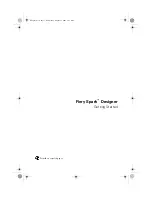
Volume 2, Part 2: Interruptions and Serialization
2:537
Interruptions and Serialization
3
This chapter discusses the interruption and serialization model. Although the Itanium
architecture is an explicitly parallel architecture, faults and traps are delivered in
program order based on IP, and from left-to-right in each instruction group. In other
words, faults and traps are reported precisely on the instruction that caused them.
3.1
Terminology
In the Itanium architecture, an
interruption
is an event which causes the hardware
automatically to stop execution of the current instruction stream, and start execution at
the instruction address corresponding to the
interruption handler
for that
interruption. When this happens, we say that an interruption has been
delivered
to the
processor core.
There are two classes of interruptions in the Itanium architecture.
IVA-based
interruptions
are handled by the operating system (OS), at an address determined by
the location of the interrupt vector table (IVT) and the particular interruption that has
occurred.
PAL-based interruptions
are handled by the processor firmware.
PAL-based interruptions are not visible to the OS, though PAL may notify the OS that a
PAL-based interruption has occurred; see
Section 13.3, “Event Handling in Firmware”
The architecture supports several different types of interruptions. These are defined
below:
• A
fault
occurs when OS intervention is required before the current instruction can
be executed. For example, if the current instruction misses the TLBs on a data
reference, a Data TLB Miss fault may be delivered by the processor. Faults are
delivered precisely on the instruction that caused the fault. The faulting instruction
and all subsequent instructions do not update any architectural state (with the
possible exception of subsequent instructions which violate a resource
dependency
1
). All instructions executed prior to the faulting instruction update all
their architectural state before the fault handler begins execution.
• A
trap
occurs when OS intervention is required after the current instruction has
completed. For example, if the last instruction executed was a branch and PSR.tb is
1, a Taken Branch trap will be delivered after the instruction completes. Traps are
delivered precisely on the instruction following the trapping instruction. The
trapping instruction and all prior instructions update all their architectural state
before the trap handler begins execution. All instructions subsequent to the
trapping instruction do not update any architectural state.
1.
When an interruption is delivered on an instruction whose instruction group contains one or more
illegal dependency violations, instructions which follow the interrupted instruction in program order
and which violate the resource dependency may appear to complete before the interruption handler
begins execution. Software cannot rely upon the value(s) written to the resource(s) whose depen-
dencies have been violated; the value(s) are undefined. For details refer to
Summary of Contents for ITANIUM ARCHITECTURE - SOFTWARE DEVELOPERS VOLUME 3 REV 2.3
Page 1: ......
Page 11: ...x Intel Itanium Architecture Software Developer s Manual Rev 2 3 ...
Page 13: ...1 2 Intel Itanium Architecture Software Developer s Manual Rev 2 3 ...
Page 33: ...1 22 Volume 1 Part 1 Introduction to the Intel Itanium Architecture ...
Page 57: ...1 46 Volume 1 Part 1 Execution Environment ...
Page 147: ...1 136 Intel Itanium Architecture Software Developer s Manual Rev 2 3 ...
Page 149: ...1 138 Volume 1 Part 2 About the Optimization Guide ...
Page 191: ...1 180 Volume 1 Part 2 Predication Control Flow and Instruction Stream ...
Page 230: ......
Page 248: ...236 Intel Itanium Architecture Software Developer s Manual Rev 2 3 ...
Page 250: ...2 2 Intel Itanium Architecture Software Developer s Manual Rev 2 3 ...
Page 264: ...2 16 Volume 2 Part 1 Intel Itanium System Environment ...
Page 380: ...2 132 Volume 2 Part 1 Interruptions ...
Page 398: ...2 150 Volume 2 Part 1 Register Stack Engine ...
Page 486: ...2 238 Volume 2 Part 1 IA 32 Interruption Vector Descriptions ...
Page 750: ...2 502 Intel Itanium Architecture Software Developer s Manual Rev 2 3 ...
Page 754: ...2 506 Volume 2 Part 2 About the System Programmer s Guide ...
Page 796: ...2 548 Volume 2 Part 2 Interruptions and Serialization ...
Page 808: ...2 560 Volume 2 Part 2 Context Management ...
Page 842: ...2 594 Volume 2 Part 2 Floating point System Software ...
Page 850: ...2 602 Volume 2 Part 2 IA 32 Application Support ...
Page 862: ...2 614 Volume 2 Part 2 External Interrupt Architecture ...
Page 870: ...2 622 Volume 2 Part 2 Performance Monitoring Support ...
Page 891: ......
Page 1099: ...3 200 Volume 3 Instruction Reference padd Interruptions Illegal Operation fault ...
Page 1295: ...3 396 Volume 3 Resource and Dependency Semantics ...
Page 1296: ......
Page 1302: ...402 Intel Itanium Architecture Software Developer s Manual Rev 2 3 ...
Page 1494: ...4 192 Volume 4 Base IA 32 Instruction Reference FWAIT Wait See entry for WAIT ...
Page 1647: ...Volume 4 Base IA 32 Instruction Reference 4 345 ROL ROR Rotate See entry for RCL RCR ROL ROR ...
Page 1884: ...4 582 Volume 4 IA 32 SSE Instruction Reference ...
Page 1885: ...Index Intel Itanium Architecture Software Developer s Manual Rev 2 3 Index ...
Page 1886: ...Index Intel Itanium Architecture Software Developer s Manual Rev 2 3 ...
Page 1898: ...INDEX Index 12 Index for Volumes 1 2 3 and 4 ...
















































